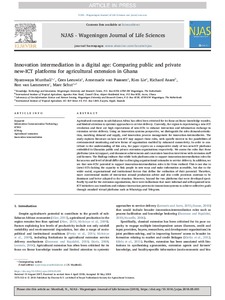| dc.contributor.author | Munthali, N. |
| dc.contributor.author | Leeuwis, C. |
| dc.contributor.author | Paassen, A. van |
| dc.contributor.author | Lie, R. |
| dc.contributor.author | Asare, R. |
| dc.contributor.author | Lammeren, R. van |
| dc.contributor.author | Schut, Marc |
| dc.date.accessioned | 2019-12-04T11:23:39Z |
| dc.date.available | 2019-12-04T11:23:39Z |
| dc.date.issued | 2018-06-13 |
| dc.identifier.citation | Munthali, N., Leeuwis, C., van Paassen, A., Lie, R., Asare, R., van Lammeren, R. & Schut, M. (2018). Innovation intermediation in a digital age: comparing public and private new-ICT platforms for agricultural extension in Ghana. NJAS-Wageningen Journal of Life Sciences. 1-13. |
| dc.identifier.issn | 1573-5214 |
| dc.identifier.uri | https://hdl.handle.net/20.500.12478/4085 |
| dc.description.abstract | Agricultural extension in sub-Saharan Africa has often been criticised for its focus on linear knowledge transfer, and limited attention to systemic approaches to service delivery. Currently, the region is experiencing a new-ICT revolution and there are high expectations of new-ICTs to enhance interaction and information exchange in extension service delivery. Using an innovation systems perspective, we distinguish the roles demand-articulation, matching demand and supply, and innovation process management for innovation-intermediaries. The study explores literature on how new-ICT may support these roles, with specific interest in the possibilities of environmental monitoring and new forms of organisation enabled by enhanced connectivity. In order to contribute to the understanding of this area, the paper reports on a comparative study of two new-ICT platforms embedded in Ghanaian public and private extension organisations respectively. We assess the roles that these platforms (aim to) support, and document achievements and constraints based on interviews with extension staff and farmers. The findings indicate that while both platforms aim to support innovation-intermediation roles the focus areas and level of detail differ due to diverging organisational rationales to service delivery. In addition, we see that new-ICTs' potential to support innovation-intermediation roles is far from realised. This is not due to (new) ICTs lacking the capacity to link people in new ways and make information accessible, but due to the wider social, organisational and institutional factors that define the realisation of their potential. Therefore, more conventional modes of interaction around production advice and also credit provision continue to be dominant and better adapted to the situation. However, beyond the two platforms that were developed specifically by and for the extension organisations, there were indications that more informal and self-organised new-ICT initiatives can transform and enhance interaction patterns in innovations systems to achieve collective goals through standard virtual platforms such as WhatsApp and Telegram. |
| dc.format.extent | 1-13 |
| dc.language.iso | en |
| dc.subject | Information And Communication Technology |
| dc.subject | Agricultural Extension |
| dc.subject | Innovation |
| dc.subject | Appropriate Technology |
| dc.title | Innovation intermediation in a digital age: comparing public and private new-ICT platforms for agricultural extension in Ghana |
| dc.type | Journal Article |
| dc.description.version | Peer Review |
| cg.contributor.crp | Agriculture for Nutrition and Health |
| cg.contributor.affiliation | Wageningen University and Research Centre |
| cg.contributor.affiliation | International Institute of Tropical Agriculture |
| cg.coverage.region | Africa |
| cg.coverage.region | West Africa |
| cg.coverage.country | Nigeria |
| cg.creator.identifier | Marc Schut: 0000-0002-3361-4581 |
| cg.researchtheme | NATURAL RESOURCE MANAGEMENT |
| cg.researchtheme | SOCIAL SCIENCE & AGRIBUSINESS |
| cg.isijournal | ISI Journal |
| cg.authorship.types | CGIAR and advanced research institute |
| cg.iitasubject | Agribusiness |
| cg.iitasubject | Farming Systems |
| cg.iitasubject | Knowledge Management |
| cg.iitasubject | Natural Resource Management |
| cg.journal | NJAS-Wageningen Journal of Life Sciences |
| cg.howpublished | Formally Published |
| cg.accessibilitystatus | Limited Access |
| local.dspaceid | 99422 |
| cg.targetaudience | Scientists |
| cg.identifier.doi | https://dx.doi.org/10.1016/j.njas.2018.05.001 |

